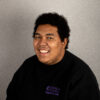It’s 1 a.m. You’re asleep in your bed or up finishing that one paper you knew about weeks ago but haven’t started yet.
Not Lizzy or Oscar. They are at the hospital working.Lizzy Diaz and Oscar Ramirez Garcia, both senior nursing majors, are night shift workers at Goshen Hospital.
“I started working the night shift in The Birthplace last August,” Diaz said. “I stayed on night shift for nine or 10 months. Now I work both days and nights. As a casual employee, I’m able to pick shifts that work for my schedule which is a huge improvement from when I was working part-time nights only.”
Unlike Diaz, Garcia began working the night shift more recently.
“I’ve only worked night shifts at the hospital for about a month,” he said. “I did an internship at the hospital over the summer, and my schedule was 8 a.m. to 4 p.m. Once this was over, I picked up some shifts as an emergency department screener and that was nights.”
“I either start at 7 p.m. and get off at 7 a.m. or 1 a.m. to 7 a.m.,” Garcia said.
On top of Garcia’s normal work, COVID-19 has shifted the way in which people are entering the hospital.
“Not everyone that comes to the emergency department has COVID-19, so the hospital had to think of a way to pre-screen the patients before they can come in through the emergency door,” Garcia said. “When the patient comes in, we greet them at the door and we talk to them through the public address system.”
“We basically just ask them if they may have been exposed to COVID-19, if they are experiencing any of the symptoms and if they have been tested. If they have been tested, we ask if they have their results. It’s an extra step we can take to avoid potential exposure while providing the care they need,” Garcia said.
Beyond the emergency department, Garcia has trained in other areas during his time at Goshen Hospital.
“I trained as a nursing assistant, and my duties are basically to answer patients’ call lights and assist them on tasks they’re unable to do because of their illness,” he said. “I assist the nursing staff in providing the best possible care so that the patients can recover quickly.”
“I am also doing some training to be a specialty tech,” he said. “In this role I am in charge of monitoring patients that have heart monitors that monitor their heart rhythms. If I observe a patient’s heart rhythm change from their baseline, it would be my responsibility to inform the nurse and document what happened.”
Being a full-time student, night shift was the best way for Garcia to work.
“I don’t have much of an option of working days throughout the week, so I found a job at the Constant Spring where I was able to work Thursdays to Saturday and those shifts started after 5 p.m.,” he said. “It was really the only way I could make some money while still attending school during the day throughout the week. Similarly, being a full-time nursing student, I can only work certain hours throughout the week and I found that working nights at the hospital would work best for my schedule.”
Diaz found night shifts to be the only shifts available when she first started at the hospital.
“At the time I applied to work at Goshen Hospital, most of the openings were for night shift. Day shift positions are quite competitive, it seems like. It also worked best for my schedule.”
“I was working as a unit secretary and nursing assistant in The Birthplace until a little over a month ago,” she said. “I did a lot of cleaning and restocking but I also got to give baby baths, do hearing screen tests on the babies, assist in deliveries and more ins and outs.”
This summer, Diaz moved to the emergency room.
“I had the opportunity to do an externship in the Emergency Department (ED) in addition to my work in labor and delivery. An opportunity presented itself to transfer to the department as a tech. I jumped at the opportunity because I love the fast-paced environment of the ED. I also get to practice a lot more of the practical nursing skills like starting IVs, placing casts, assisting with CPR when needed and more.”
Through it all, Diaz and Garcia agree there have been some invaluable lessons.
“It’s one thing to read about it in a textbook, but it’s another to actually see it being implemented in real life and see it work,” Garcia said.




